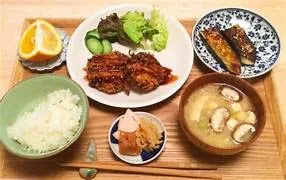1. Traditional Japanese Breakfast (Ichiju Sansai)

Ichiju
Sansai, a traditional Japanese breakfast
Ichiju Sansai, a
traditional Japanese breakfast, provides a balanced and nutritious start to the
day. It is made up of various components that work together to make a balanced
and enjoyable meal. The grilled fish adds a delightful savory ingredient with its
smoky taste and soft texture, while the steamed rice provides a warm and
nourishing basis. The miso soup, prepared with dashi and miso paste, adds
warmth and umami to the dish, which is complemented with tofu cubes, seaweed,
and green onions. Pickled veggies like umeboshi plum and tsukemono add a tart
and refreshing contrast to the other tastes on the platter. Tamagoyaki, a
savory and sweet-wrapped omelette, has a delicate and fluffy texture. Finally,
the nori seaweed sheets, which may be wrapped around bits of rice or fish,
finish off the meal. This traditional Japanese breakfast served with a cup of
green tea, gives a hearty and delicious start to the day.
Full Recipe of Ichiju Sansai
Ingredients:
1) Steamed rice,
2) grilled fish
(such as salmon or mackerel)
3) miso soup are
all acceptable options.
4) Pickled
vegetables, such as tsukemono or umeboshi plum
3) Sheets of
nori seaweed
4) Tamagoyaki (a
wrapped omelet from Japan)
5) Green tea
Instructions:
1. Begin by
making steamed rice using a rice cooker or following the directions on the
package.
2. Prepare the
grilled fish by seasoning it with salt and pepper while the rice is cooking.
Grill the fish until it is fully done and has developed a light char.
3. To make miso
soup, combine dashi (Japanese soup stock) and miso paste in a small saucepan
and bring to a boil. Tofu cubes, seaweed, and finely chopped green onions can
be added to improve the flavor.
4. Arrange
various pickled vegetables on a small platter, such as umeboshi plum or
tsukemono.
5. To make
tamagoyaki, combine eggs, soy sauce, and a dash of sugar in a bowl. Roll the
ingredients into a log form while it cooks in a rectangle frying pan or
tamagoyaki pan. The wrapped omelet should be cut into bite-sized pieces.
6. Present the
grilled fish, miso soup, pickled vegetables, tamagoyaki, and nori seaweed
sheets together with a bowl of steamed rice.
Enjoy a cup of
hot green tea with your Japanese breakfast.
2. Okonomiyaki-style Pancakes
.webp) |
| pancakes in the Okonomiyaki style |
These savory
pancakes in the Okonomiyaki style are a delicious mix of a sweet pancake and a
traditional Japanese dish. All-purpose flour and dashi are combined to make a
batter that results in a light, fluffy pancake with a hint of umami taste. The
green onions lend a delicate acidity, while the shreds of cabbage add a cool,
crisp texture. Cooked shrimp or sliced bacon can be added to the batter to
offer a depth of flavor to those who want a heartier pancake. The pancake is
prepared such that the outside is crispy and golden while the interior is soft
and tender. These pancakes offer a pleasing fusion of sweet, acidic, and salty
flavors when topped with okonomiyaki sauce, Japanese mayonnaise, aonori (dried
seaweed flakes), and bonito flakes (katsuobushi). These pancakes are a special
and fun option for a breakfast with a Japanese influence since each mouthful is
a lovely blend of textures and flavors.
Full Recipe of Okonomiyaki-style Pancake
Ingredients:
1) Two cups of
regular flour
2) Two-thirds of
a cup of dashi (Japanese soup stock)
3) Two big eggs
4) One cup of
chopped cabbage
5) Two finely
sliced green onions
6) Optional: 1/2
cup cooked shrimp or diced bacon
7) 1/4 cup
crispy fried onions or tempura scraps
8) Okonomiyaki
sauce, which is sold at Japanese grocers
9) Japan-style
mayo
10) Aonori
(flakes of dried seaweed)
11) Flakes of
bonito (katsuobushi)
Instructions:
1. Combine the
all-purpose flour, dashi, and eggs in a large mixing basin. Smooth and
well-combined after whisking.
2. Add cooked
shrimp or chopped bacon (if using) along with the cabbage shreds and green
onions to the batter. All ingredients should be combined well.
3. Set a
nonstick griddle or frying pan to medium heat. To make a pancake with a
diameter of 6 to 8 inches, spoon some of the batter onto the pan.
4. Top the
pancake with some tenkasu or crispy fried onions. Cook it for 3 to 4 minutes,
or until the bottom is crispy and golden brown.
5. Use a spatula
to flip the pancake, then cook the opposite side for an additional 3–4 minutes.
6. When the
pancake is fully cooked through and both sides are attractively browned, place
it on a serving platter.
7. Spread
Japanese mayonnaise and okonomiyaki sauce in a crisscross manner over the
pancake.
8. Top with
bonito flakes (katsuobushi) and aonori, dried seaweed flakes.
9. To serve the
pancake as a delectable and savory Japanese breakfast choice, cut it into
slices or wedges.
Enjoy your
culinary explorations of the Japanese morning!



.webp)

.webp)

3 Comments
Great blog post on the pros and cons of food! I especially appreciated your thorough exploration of the various health benefits and potential risks associated with different types of food.
ReplyDeleteVery good bro
ReplyDeletethanx
DeleteIf you have any doubt, please let me know.